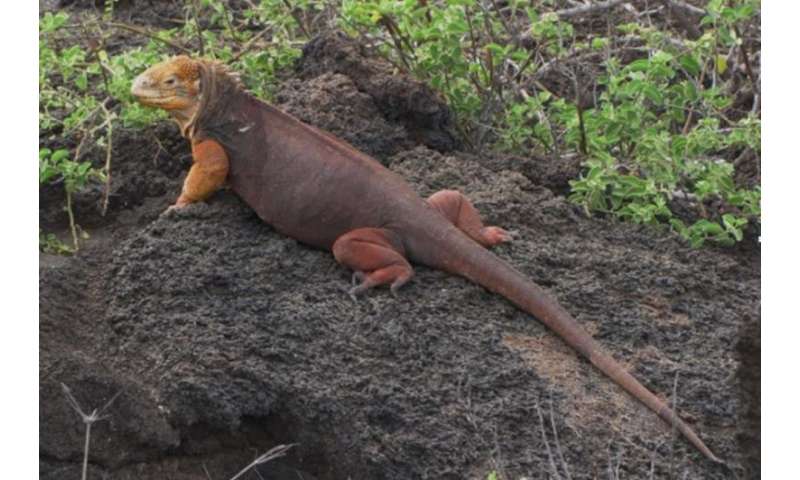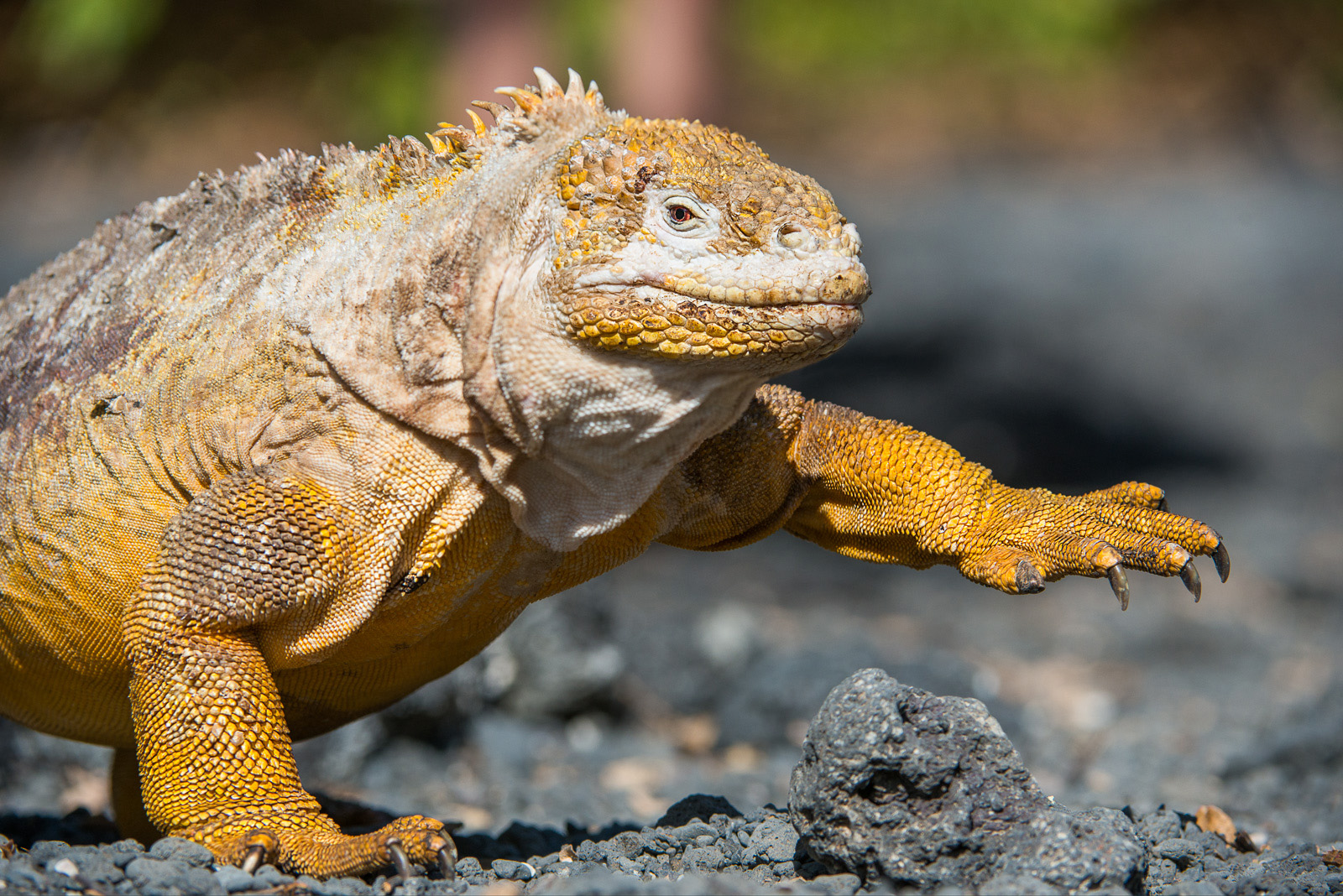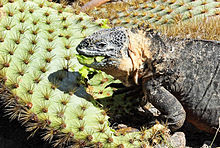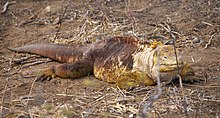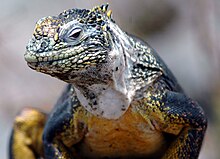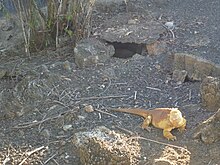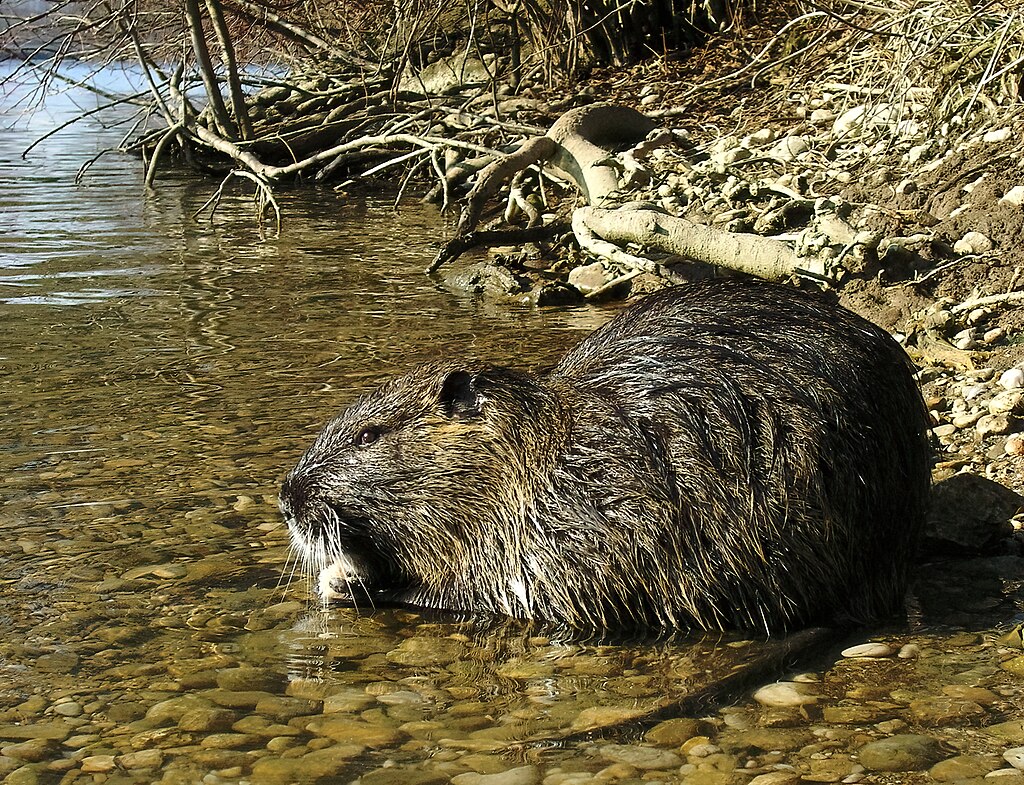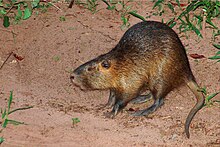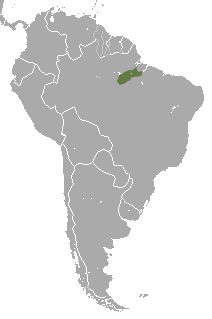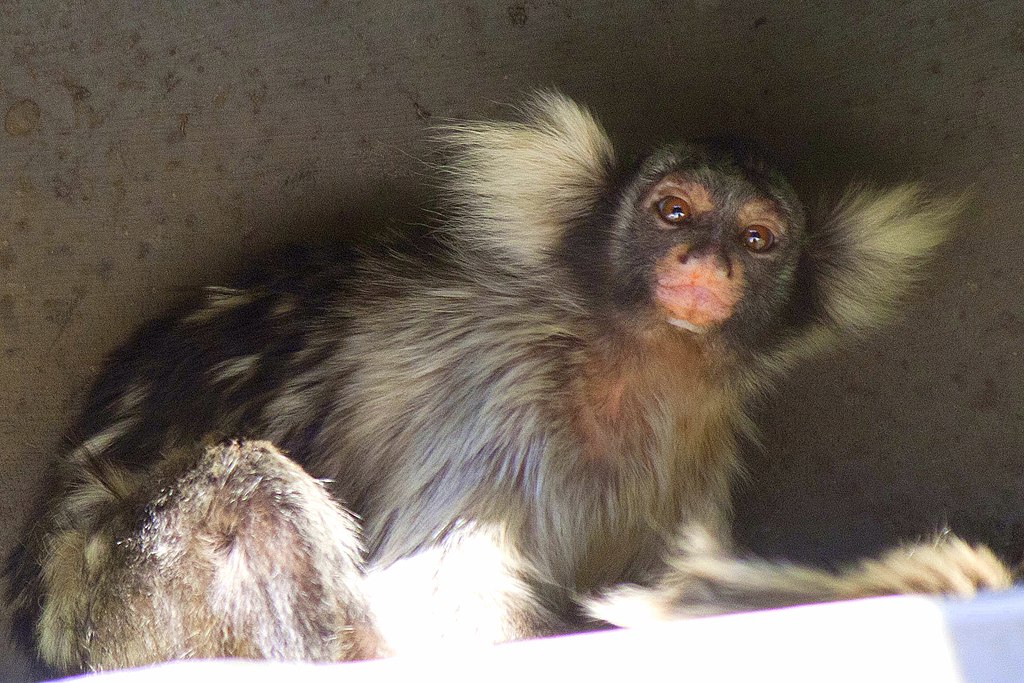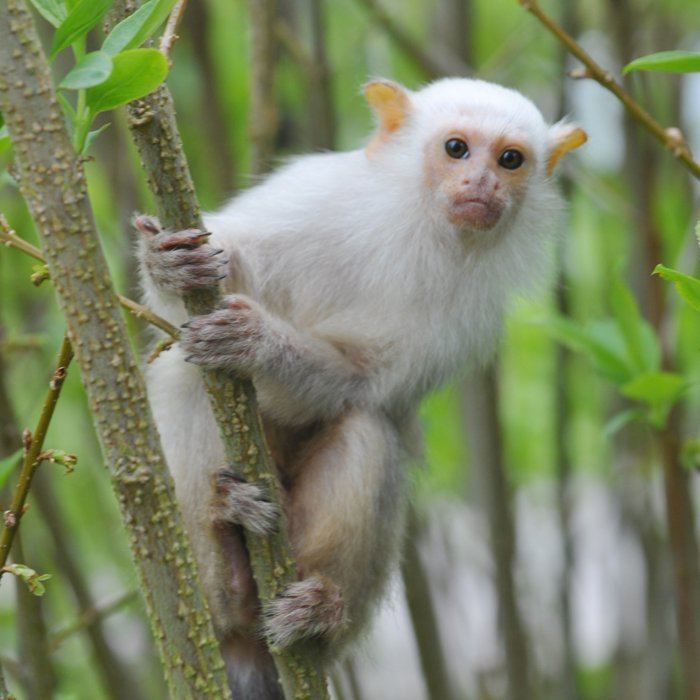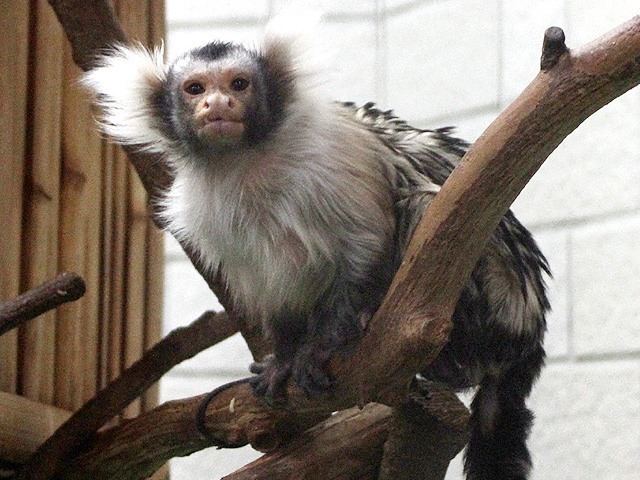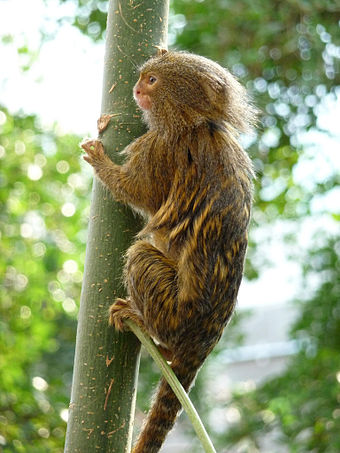The
coypu (from
Spanish coipú, from
Mapudungun koypu;
[3][4] Myocastor coypus), also known as the
nutria,
[1][5] is a large,
herbivorous,
[6] semiaquatic
rodent.
Classified for a long time as the only member of the family Myocastoridae,
[7] Myocastor is now included within
Echimyidae, the family of the spiny rats.
[8][9][2]
The coypu lives in burrows alongside stretches of water, and feeds on river plant stems.
[10]
Originally native to subtropical and temperate South America, it has
since been introduced to North America, Europe, Asia, and Africa,
primarily by fur farmers.
[11] Although it is still hunted and trapped for
its fur
in some regions, its destructive burrowing and feeding habits often
bring it into conflict with humans, and it is considered an
invasive species.
[12]
Etymology

The genus name
Myocastor derives from the two
Ancient Greek words
μῦς (
mûs), meaning "rat, mouse", and
κάστωρ (
kástōr), meaning "beaver".
[13][14][15] Literally, therefore, the name
Myocastor means "beaver rat".
Two names are commonly used in
English for
Myocastor coypus. The name "nutria" (from Spanish word
nutria, meaning 'otter') is generally used in North America, Asia, and throughout
countries of the former Soviet Union; however, in most
Spanish-speaking countries, the word "nutria" refers primarily to the
otter. To avoid this ambiguity, the name "coypu" or "coipo" (derived from the
Mapudungun language) is used in Latin America and parts of Europe.
[16] In France, the coypu is known as a
ragondin. In Dutch, it is known as
beverrat (beaver rat). In German, it is known as
Nutria,
Biberratte (beaver rat), or
Sumpfbiber (swamp beaver). In Italy, instead, the popular name is, as in North America and Asia, "nutria", but it is also called
castorino ("little
beaver"), by which its fur is known in Italy. In Swedish, the animal is known as
sumpbäver (marsh/swamp beaver). In Brazil, the animal is known as
ratão-do-banhado (big swamp rat),
nútria, or
caxingui (the last from the
Tupi language).
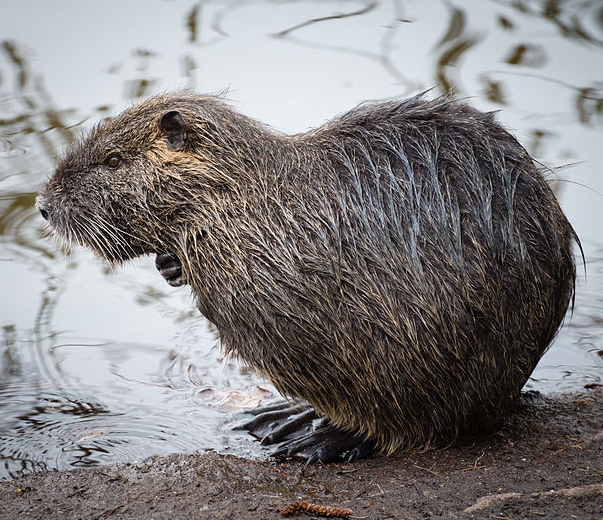
Taxonomy
The coypu was first described by
Juan Ignacio Molina in 1782 as
Mus coypus, a member of the
mouse genus.
[17] The genus
Myocastor was assigned in 1792 by
Robert Kerr.
[18]
Geoffroy Saint-Hilaire, independently of Kerr, named the species
Myopotamus coypus,
[19] and it is occasionally referred to by this name.
Four subspecies are generally recognized:
[17]
- M. c. bonariensis: northern Argentina, Bolivia, Paraguay, Uruguay, southern Brazil (RS, SC, PR, and SP)
- M. c. coypus: central Chile, Bolivia
- M. c. melanops: Chiloé Island
- M. c. santacruzae: Patagonia
M. c. bonariensis, the subspecies present in the northernmost
(subtropical) part of the coypu's range, is believed to be the type of
coypu most commonly introduced to other continents.
[16]

Phylogeny
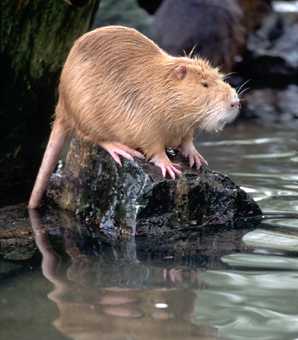
Comparison of DNA and protein sequences showed that the genus
Myocastor is the sister group to the genus
Callistomys (painted tree-rats).
[20][2] In turn, these two taxa share evolutionary affinities with other
Myocastorini genera:
Proechimys and
Hoplomys (armored rats) on the one hand, and
Thrichomys on the other hand.
| Genus-level cladogram of the Myocastorini.
|
|
|
| The cladogram has been reconstructed from mitochondrial and nuclear DNA characters.[8][9][21][20][22][23][2]
|

Appearance
Large orange teeth are clearly visible on this coypu.
The coypu somewhat resembles a very large
rat, or a
beaver
with a small tail. Adults are typically 4–9 kg (8.8–19.8 lb) in weight,
and 40–60 cm (16–24 in) in body length, with a 30 to 45 cm (12 to 18
in) tail. It is possible for coypu to weigh up to 16 to 17 kg (35 to
37 lb), although adults usually average 4.5 to 7 kg (9.9 to 15.4 lb).
[24][25][26]
They have coarse, darkish brown outer fur with soft dense grey under
fur, also called the nutria. Three distinguishing features are a white
patch on the muzzle, webbed hind feet, and large, bright orange-yellow
incisors.
[27] The
nipples of female coypu are high on her flanks, to allow their young to feed while the female is in the water.
A coypu is often mistaken for a
muskrat,
another widely dispersed, semiaquatic rodent that occupies the same
wetland habitats. The muskrat, however, is smaller and more tolerant of
cold climates, and has a laterally flattened tail it uses to assist in
swimming, whereas the tail of a coypu is round. It can also be mistaken
for a small beaver, as beavers and coypus have very similar anatomies.
However, beavers' tails are flat and paddle-like, as opposed to the
round tails of coypus.
[28]
Life history
Coypus can live up to six years in captivity, but individuals
uncommonly live past three years old; according to one study, 80% of
coypus die within the first year, and less than 15% of a wild population
is over three years old.
[29]
Male coypus reach sexual maturity as early as four months, and females
as early as three months; however, both can have a prolonged
adolescence, up to the age of 9 months. Once a female is pregnant,
gestation
lasts 130 days, and she may give birth to as few as one or as many as
13 offspring. They generally line nursery nests with grasses and soft
reeds. Baby coypus are
precocial,
born fully furred and with open eyes; they can eat vegetation with
their parents within hours of birth. A female coypu can become pregnant
again the day after she gives birth to her young. If timed properly, a
female can become pregnant three times within a year. Newborn coypus
nurse for seven to eight weeks, after which they leave their mothers.
[30]
Habitat and feeding
A coypu in a canal in Milan
Besides breeding quickly, each coypu consumes large amounts of
vegetation. An individual consumes about 25% of its body weight daily,
and feeds year-round.
[30][31]
Being one of the world's larger extant rodents, a mature, healthy
coypu averages 5.4 kg (12 lb) in weight, but they can reach as much as
10 kg (22 lb).
[32][33] They eat the base of the above-ground stems of plants, and often dig through the organic soil for roots and
rhizomes to eat.
[34]
Their creation of "eat-outs", areas where a majority of the above- and
below-ground biomass has been removed, produces patches in the
environment, which in turn disrupts the habitat for other animals and
humans dependent on marshes.
[35]
Coypus are found most commonly in freshwater marshes, but also inhabit brackish marshes and rarely salt marshes.
[36][37] They either construct their own burrows, or occupy burrows abandoned by beaver, muskrats, or other animals.
[12] They are also capable of constructing floating rafts out of vegetation.
[12]
Commercial and environmental issues
Local extinction in their native range due to overharvesting led to
the development of coypu fur farms in the late 19th and early 20th
centuries. The first farms were in Argentina and then later in Europe,
North America, and Asia. These farms have generally not been successful
long-term investments, and farmed coypu often are released or escape as
operations become unprofitable. The first attempt at coypu farming was
in France in the early 1880s, but it was not much of a success.
[38] The first efficient and extensive coypu farms were located in South America in the 1920s.
[38]
The South American farms were very successful, and led to the growth of
similar farms in North America and Europe. Coypus from these farms
often escaped, or were deliberately released into the wild to provide a
game animal or to remove aquatic vegetation.
[39]
Coypus were introduced to the Louisiana ecosystem in the 1930s,
when they escaped from fur farms that had imported them from South
America. Coypu were released into the wild by at least one Louisiana
nutria farmer in 1933 and these releases were followed by
E. A. McIlhenny who released his entire stock in 1945 on Avery Island.
[40]
In 1940, some of the nutria escaped during a hurricane and quickly
populated coastal marshes, inland swamps, and other wetland areas.
[41] From Louisiana, coypus have spread across the Southern United States, wreaking havoc on marshland.
Following a decline in demand for coypu fur, coypu have since
become pests in many areas, destroying aquatic vegetation, marshes, and
irrigation
systems, and chewing through man-made items such as tires and wooden
house panelling in Louisiana, eroding river banks, and displacing native
animals. Damage in Louisiana has been sufficiently severe since the
1950s to warrant legislative attention; in 1958, the first bounty was
placed on nutria, though this effort was not funded.
[42]:3
By the early 2000s, the Coastwide Nutria Control Program was
established, which began paying bounties for nutria killed in 2002.
[42]:19–20 In the
Chesapeake Bay region in
Maryland,
where they were introduced in the 1940s, coypus are believed to have
destroyed 7,000 to 8,000 acres (2,800 to 3,200 ha) of marshland in the
Blackwater National Wildlife Refuge. In response, by 2003, a multimillion-dollar eradication program was underway.
[43]
In the United Kingdom, coypus were introduced to
East Anglia, for fur, in 1929; many escaped and damaged the drainage works, and a concerted programme by
MAFF eradicated them by 1989.
[44] However, in 2012, a "giant rat" was killed in
County Durham, with authorities suspecting the animal was, in fact, a coypu.
[45]
Marsh Dog, a US company based in Baton Rouge, Louisiana, received
a grant from the Barataria-Terrebonne National Estuary Program to
establish a company that uses nutria meat for dog food products.
[46]
In 2012, the Louisiana Wildlife Federation recognized Marsh Dog with
"Business Conservationist of the Year" award for finding a use for this
ecosustainable protein.
[47]
In Kyrgyzstan and Uzbekistan, nutria (Russian and local languages
Нутрия) are farmed on private plots and sold in local markets as a poor
man's meat.
[48] As of 2016, however, the meat is used successfully in Moscow restaurant Krasnodar Bistro, as part of the growing Russian
localvore movement and as a '
foodie' craze.
[48]
It appears on the menu as a burger, hotdog, dumplings, or wrapped in
cabbage leaves, with the flavour being somewhere between turkey and
pork.
[49]
In addition to direct environmental damage, coypus are the host for a
nematode parasite (
Strongyloides myopotami) that can infect the skin of humans, causing dermatitis similar to
strongyloidiasis.
[50] The condition is also called "nutria itch".
[51]
Distribution
Native
to subtropical and temperate South America, it has since been
introduced to North America, Europe, Asia, and Africa, primarily by fur
ranchers.
The distribution of coypus outside South America tends to contract or
expand with successive cold or mild winters. During cold winters, coypus
often suffer
frostbite
on their tails, leading to infection or death. As a result,
populations of coypus often contract and even become locally or
regionally
extinct as in the
Scandinavian countries and such US states as Idaho, Montana, and Nebraska during the 1980s.
[52]
During mild winters, their ranges tend to expand northward. For
example, in recent years, range expansions have been noted in Washington
and Oregon,
[53] as well as Delaware.
[54]
According to the
U.S. Geological Survey, nutria were first introduced to the United States in
California, in 1899. They were first brought to
Louisiana
in the early 1930s for the fur industry, and the population was kept in
check, or at a small population size, because of trapping pressure from
the fur traders.
[16]
The earliest account of nutria spreading freely into Louisiana wetlands
from their enclosures was in the early 1940s; a hurricane hit the
Louisiana coast for which many people were unprepared, and the storm
destroyed the enclosures, enabling the nutria to escape into the wild.
[16] According to the Louisiana Department of Wildlife and Fisheries, nutria were also transplanted from
Port Arthur, Texas, to the
Mississippi River in 1941 and then spread due to a hurricane later that year.
[55]
Herbivory damage to wetlands
Nutria herbivory "severely reduces overall wetland biomass and can lead to the conversion of wetland to open water.
[31]
" Unlike other common disturbances in marshlands, such as fire and
tropical storms, which are a once- or few-times-a-year occurrence,
nutria feed year round, so their effects on the marsh are constant.
Also, nutria are typically more destructive in the winter than in the
growing season, due largely to the scarcity of above-ground vegetation;
as nutria search for food, they dig up root networks and rhizomes for
food.
[34] While nutria are the most common herbivores in Louisiana marshes, they are not the only ones. Feral hogs, also known as
wild boars (
Sus scrofa),
swamp rabbits (
Sylvilagus aquaticus), and
muskrats (
Ondatra zibethicus)
are less common, but feral hogs are increasing in number in Louisiana
wetlands. On plots open to nutria herbivory, 40% less vegetation was
found than in plots guarded against nutria by fences. This number may
seem insignificant, and indeed herbivory alone is not a serious cause of
land loss, but when herbivory was combined with an additional
disturbance, such as fire, single vegetation removal, or double
vegetation removal to simulate a tropical storm, the effect of the
disturbances on the vegetation were greatly amplified.
[31]
" Essentially, this means, as different factors were added together,
the result was less overall vegetation. Adding fertilizer to open plots
did not promote plant growth; instead, nutria fed more in the fertilized
areas. Increasing fertilizer inputs in marshes only increases nutria
biomass instead of the intended vegetation, therefore increasing
nutrient input is not recommended.
[31]
Wetlands in general are a valuable resource both economically and environmentally. For instance, the
U.S. Fish and Wildlife Service
determined wetlands covered only 5% of the land surface of the
contiguous 48 United States, but they support 31% of the nation's plant
species.
[56]
These very biodiverse systems provide resources, shelter, nesting
sites, and resting sites (particularly Louisiana's coastal wetlands such
as
Grand Isle
for migratory birds) to a wide array of wildlife. Human users also
receive many benefits from wetlands, such as cleaner water, storm surge
protection, oil and gas resources (especially on the Gulf Coast),
reduced flooding, and chemical and biological waste reduction, to name a
few.
[56]
In Louisiana, rapid wetland loss occurs due to a variety of reasons;
this state loses an estimated area about the size of a football field
every hour. The problem became so serious that Sheriff
Harry Lee of
Jefferson Parish used
SWAT sharpshooters against the animals.
[58]
In 1998, the Louisiana Department of Wildlife and Fisheries
(LDWF) conducted the first Louisiana coast-wide survey, which was funded
by the
Coastal Wetlands Planning, Protection, and Restoration Act and titled the Nutria Harvest and Wetland Demonstration Program, to evaluate the condition of the marshlands.
[59]
The survey revealed through aerial surveys of transects that herbivory
damage to wetlands totaled roughly 90,000 acres. The next year, LDWF
performed the same survey and found the area damaged by herbivory
increased to about 105,000 acres.
[36]
The LDWF has determined the wetlands affected by nutria decreased from
an estimated 80,000+ acres of Louisiana wetlands in 2002–2003 season to
about 6,296 acres during the 2010–2011 season.
[60]
The LDWF stresses that coastal wetland restoration projects will be
greatly hindered without effective, sustainable nutria population
control.
A claimed environmentally sound solution is the use of nutria meat to make dog food treats.
[61]
Control efforts
New Zealand
Coypus are classed as a "prohibited new organism" under New Zealand's
Hazardous Substances and New Organisms Act 1996, preventing it from being imported into the country.
[62]
Great Britain
In
the UK, coypu escaped from fur farms and were reported in the wild as
early as 1932. There were three unsuccessful attempts to control coypu
in east Great Britain between 1943 and 1944. Coypu population and range
increased causing damage to agriculture in the 1950s. During the 1960s, a
grant was awarded to Rabbit Clearance Societies that included coypu.
This control allowed for the removal of 97,000 coypu in 1961 and 1962.
From 1962 to 1965, 12 trappers were hired to eradicate as many coypu as
possible near Norfolk Broads. The campaign used live traps allowing
non-target species to be released while any coypu caught were killed by
gun. Combined with cold winters in 1962 to 1963, almost 40,500 coypu
were removed from the population. Although coypu populations were
greatly reduced after the 1962-1965 campaign ended, the population
increased until another eradication campaign began in 1981. This
campaign succeeded in fully eradicating coypu in Great Britain. The
trapping areas were broken into 8 sectors leaving no area uncontrolled.
The 24 trappers were offered an incentive for early completion of the
10-year campaign. In 1989 coypu were assumed eradicated as only 3 males
were found between 1987 and 1989.
[63]
Ireland
A coypu was first sighted in the wild in Ireland in 2010.
Some coypu escaped from a pet farm in
Cork City in 2015 and began breeding on the outskirts of the city. Ten were trapped on the
Curraheen River in 2017, but the rodents continued to spread, reaching
Dublin via the
Royal Canal in 2019.
[64][65][66] Animals were found along the
River Mulkear
in 2015. The National Biodiversity Data Centre issued a species alert
in 2017, saying that coypu "[have] the potential to be a high impact
invasive species in Ireland. […] This species is listed as among 100 of
the worst invasive species in Europe."
[67]
Nutria herbivory "is perhaps the least studied or quantified aspect of wetland loss".
[59]
Many coastal restoration projects involve planting vegetation to
stabilize marshland, but this requires proper nutria control to be
successful.
Louisiana
The
Coastwide Nutria Control Program, provides incentives for harvesting
nutria. Starting in 2002, Louisiana Department of Wildlife and Fisheries
(LDWF) has performed aerial surveys just as they had done for the
Nutria Harvest and Wetland Demonstration Program, only it is now under a
different program title. Under the Coastwide Nutria Control Program,
which also receives funds from
CWPPRA,
308,160 nutria were harvested the first year (2002–2003), revealing
82,080 acres damaged and totaling $1,232,640 in incentive payments paid
out to those legally participating in the program.
[60]
Essentially, once a person receives a license to hunt or trap nutria,
then that person is able to capture an unlimited number. When a nutria
is captured, the tail is cut off and turned in to a Coastal Environments
Inc. official at an approved site. Each nutria tail is worth $5, which
is an increase from $4 before the 2006–2007 season. Nutria harvesting
increased drastically during the 2009–2010 year, with 445,963 nutria
tails turned in worth $2,229,815 in incentive payments.
[60]
Each CEI official keeps record of how many tails have been turned in by
each individual per parish, the method used in capture of the nutria,
and the location of capture. All of this information is transferred to a
database to calculate the density of nutria across the Louisiana coast,
and the LDWF combines these data with the results from the aerial
surveys to determine the number of nutria remaining in the marshes and
the amount of damage they are inflicting on the ecosystem.
[60]
Another program executed by LDWF involves creating a market of
nutria meat for human consumption, though it is still trying to gain
public notice. Nutria is a very lean, protein-rich meat, low in fat and
cholesterol with the taste, texture, and appearance of rabbit or dark
turkey meat.
[68] Few
pathogens
are associated with the meat, but proper heating when cooking should
kill them. The quality of the meat and the minimal harmful
microorganisms associated with it make nutria meat an "excellent food
product for export markets".
[37]
Several desirable control methods are currently ineffective for various reasons.
Zinc phosphide
is the only rodenticide currently registered to control nutria, but it
is expensive, remains toxic for months, detoxifies in high humidity and
rain, and requires construction of (expensive) floating rafts for
placement of the chemical. It is not yet sure how many nontarget species
are susceptible to zinc phosphide, but birds and rabbits have been
known to die from ingestion.
[69]
Therefore, this chemical is rarely used, especially not in large-scale
projects. Other potential chemical pesticides would be required by the
US Environmental Protection Agency to undergo vigorous testing before
they could be acceptable to use on nutria. The LDWF has estimated costs
for new chemicals to be $300,000 for laboratory, chemistry, and field
studies, and $500,000 for a mandatory Environmental Impact Statement.
[69]
Contraception is not a common form of control, but is preferred by some
wildlife managers. It also is expensive to operate - an estimated $6
million annually to drop bait laced with birth-control chemicals.
Testing of other potential contraceptives would take about five to eight
years and $10 million, with no guarantee of FDA approval.
[69]
Also, an intensive environmental assessment would have to be completed
to determine whether any non-target organisms were affected by the
contraceptive chemicals. Neither of these control methods is likely to
be used in the near future.
[citation needed]
In Louisiana, a claimed environmentally sound solution is the killing of nutria to make dog food treats.
[61]
Atlantic coast
An eradication program on the
Delmarva Peninsula, between
Chesapeake Bay and the
Atlantic coast,
where they once numbered in the tens of thousands and had destroyed
thousands of acres of marshland, had nearly succeeded by 2012.
[70]
California
The first records of nutria invading California dates from the 1940s and 50s, when it was found in the agriculture-rich
Central Valley and the south coast of the state, but by the 1970s the animals had been extirpated statewide.
[71]. They were found again in
Merced County in 2017, on the edge of the
San Joaquin River Delta. State officials are concerned that they will harm infrastructure that sends water to
San Joaquin Valley farms and urban areas.
[72] In 2019, the
California Department of Fish and Wildlife (CDFW) received nearly $2 million in
Governor Gavin Newsom's first budget, and an additional $8.5 million via the
Delta Conservancy (a state agency focused on the Delta) to be spent over the course of three years.
[73] The state has adopted an eradication campaign based on the successful effort in the
Chesapeake Bay, including strategies such as the "
Judas nutria" (in which individualized nutria are caught, sterilized, fitted with
radio collars, and released, whereupon they can be tracked by hunters as they return to their colonies) and the use of trained dogs.
[73] The state has also reversed a prior "no-hunting" policy, although hunting the animals does require a license.
[73]
Gallery
-
Wild Coypu in Oise river in France
10-day-old baby coypu
Myocastor coypus
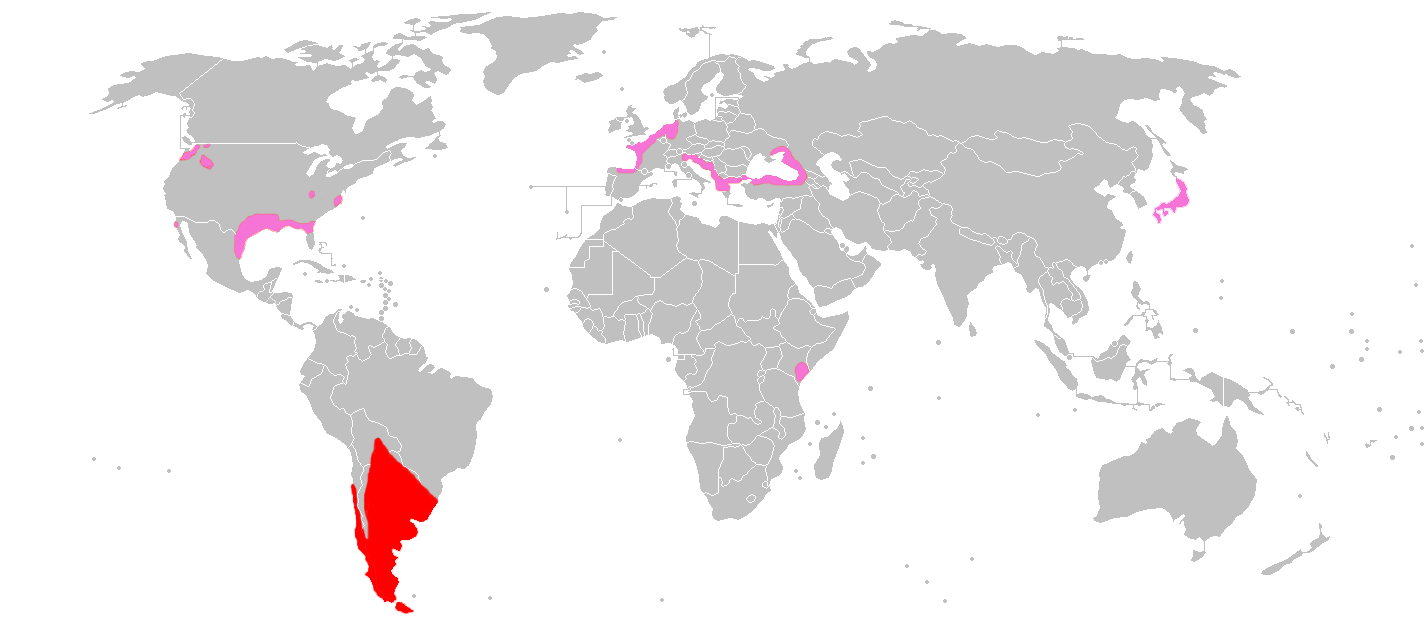
Coypu
range; native in red, introduced in pink





